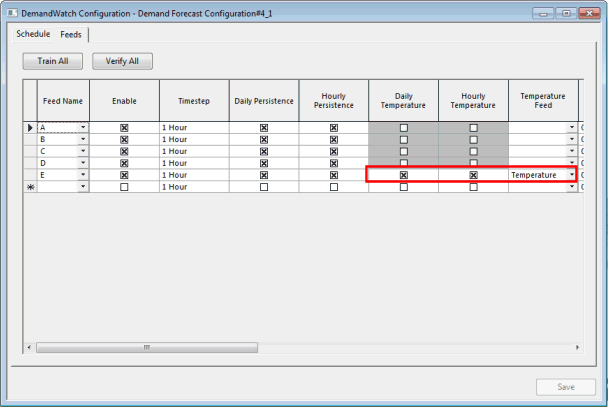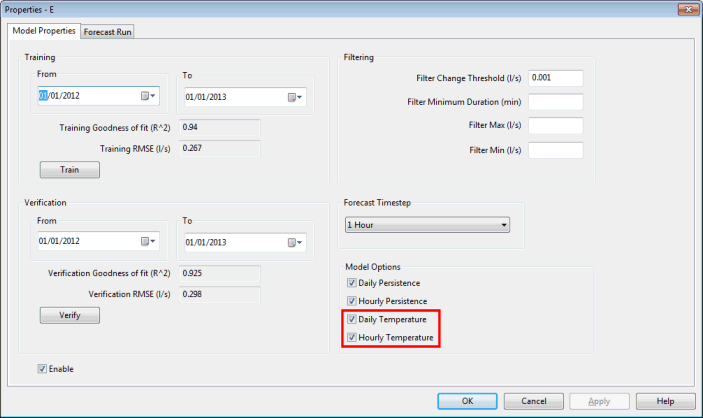Daily temperature can be added as an optional regression factor.
Effect of temperature on the predictive power of InfoWorks WS Pro
Studies carried out by Autodesk have shown that historical and forecast temperature data made a marginal improvement (3% to 5% of variance) for the next few hours and moderately strong improvement further ahead.
This means that InfoWorks WS Pro can take into account unexpected temperature changes, which is especially important during unusually very hot summer days. InfoWorks WS Pro training requires historical demand data at hourly intervals and temperature data at daily intervals. At least one year’s worth of historical data is required for training. Please note that the use of temperature data is entirely optional. If no historical weather data or weather forecasts are available, InfoWorks WS Pro will still compute a prediction for future demand.
DemandWatch can model the effect of unexpected temperature changes on daily demand by taking the difference between the temperature forecast and the historical average temperature for that particular season. This difference in temperature is then multiplied by a regression factor and added to the predicted daily demand. This means that if the weather forecast is hotter than average, the predicted demand will be increased.
For example, for a InfoWorks WS Pro prediction for a Wednesday in summer in Wallingford (UK) InfoWorks WS Pro uses historic data for the same period last year to predict an expected daily demand of say 3.5 l/s. If the weather forecast for tomorrow is a maximum temperature of 30⁰C, and the average maximum temperature in summer in Wallingford is 20⁰C, InfoWorks WS Pro will add the temperature difference (10⁰C) multiplied by a factor calculated by performing regression on the historical data. Assuming a factor of 0.1 l/s/⁰C is calculated, the weather corrected predicted daily demand is 3.5 + 0.1 x (30-20) = 4.5 l/s.
If for some reason the weather forecast is not available, InfoWorks WS Pro will use the average value for Wednesdays in summer from the historic data instead.
Connection to Temperature Feeds
As detailed above, a temperature feed can be used to supply temperature data to InfoWorks WS Pro in order to improve forecast accuracy.
Connection to temperature data is set up in the same way as connection to demand feeds, i.e. in the Live Data Feed tab of the Live Data Configuration object.
The main difference is that the external units (External Units field) must be set to DegC or DegF. In other words any feed with external units other than degC and degF will not be considered as a temperature feed by InfoWorks WS Pro.

Temperature Feed Configuration
Temperature feed configuration is implemented in the Feeds Page of the DemandWatch Configuration object, just like for any other feed.
The only difference is that the Temperature feed field must be used. If this field is set, InfoWorks WS Pro will use the related feed to retrieve historic and forecast daily maximum temperature information:
Only temperature feeds will appear in the Temperature Feed dropdown list.
The temperature regression has two components:
- a daily temperature model that adjusts the daily demand forecast.
- an hourly model that adjusts the hourly forecast.
These components can be enabled in the Feeds page, by checking the Daily Temperature and the Hourly Temperature box respectively.

These two components can also be set or modified for the currently selected feed, in the Model Properties page of the Properties dialog.

IMPORTANT: The hourly temperature model requires only daily temperature data. Hourly temperature data is NOT required. In fact, if more than one temperature value is available on a particular day, InfoWorks WS Pro will take the maximum value.
If a temperature feed has been set, InfoWorks WS Pro will read the temperature and use it in the training, verification, and forecast phases.